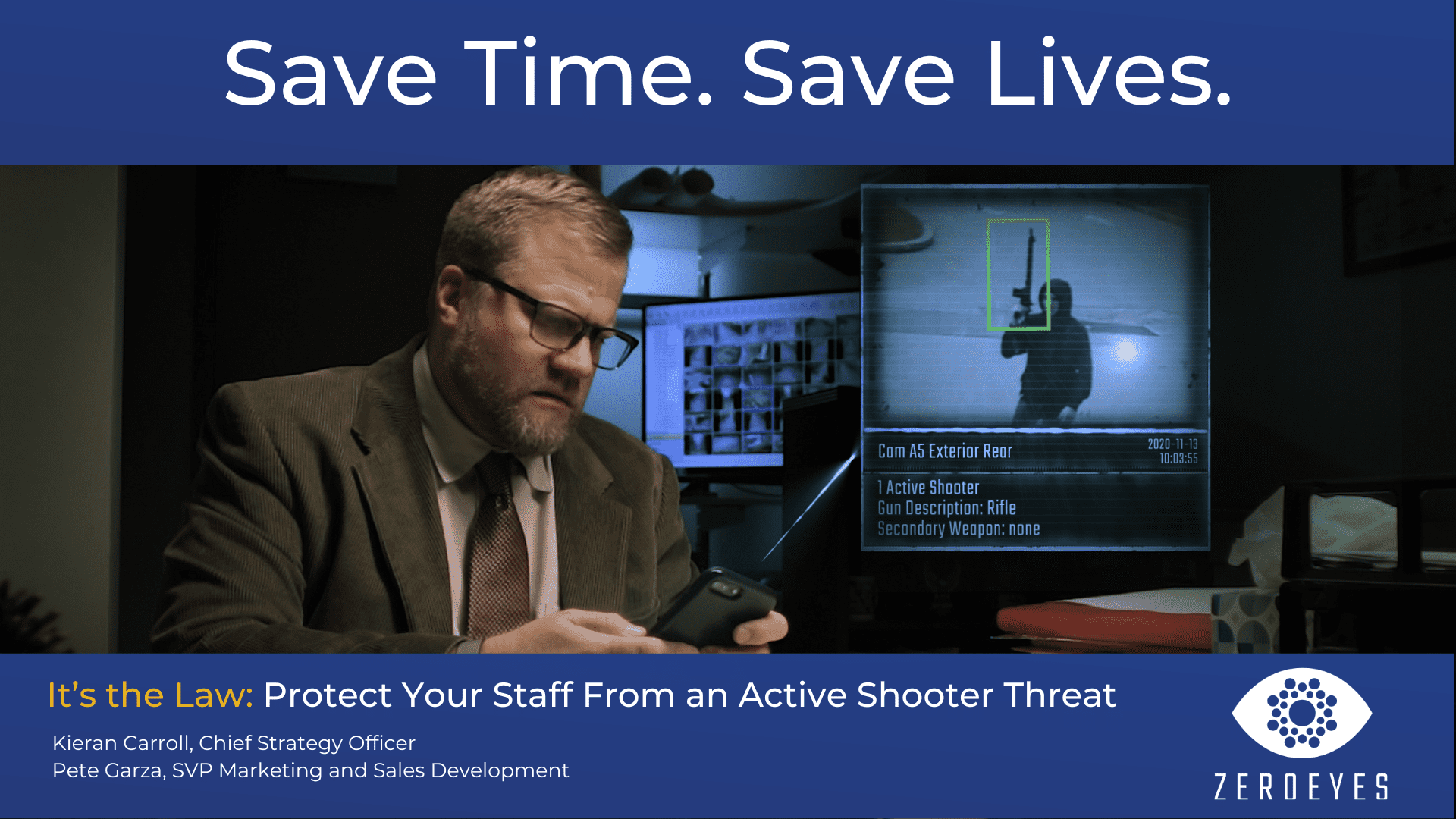In the last 20 years, there have been about four times as many mass shootings in the workplace as there have been in schools. While no one can predict a mass shooting, proper response protocols and safety measures are becoming more critical to Duty of Care compliance. In fact, many companies in recent years have been sued for negligence of Duty of Care because they were accused of not providing a safe working environment for the prevention and response to active shooter events.
While workplace safety has always been top of mind for employers, today’s priorities aren’t all about occupational hazards from machine-related injuries or working with asbestos. The category of mass shootings is as much of a business safety concern as anything OSHA could’ve predicted when it was founded in 1971.
To illustrate how safety is a top priority for workers more than ever before, let’s look at some data points. In a 2022 survey of 2,000 workers across various industries, the following employee perceptions of workplace safety were found:
- 90% believe their employers have a moral and legal obligation to protect them from unnecessary risk or harm while working.
- 47% of workers say they are more motivated to stay with an employer that genuinely cares for their safety—the top reason following competitive compensation.
- 53% of employers are very concerned about workplace violence happening at their place of work, and 19% have actually experienced workplace violence.
Despite the overwhelming concern for safety in the workplace, only 39% of U.S. businesses have a crisis plan in place considered “very relevant” according to a recent global crisis survey from PricewaterhouseCoopers (PwC).
But peace of mind is not the only thing that should keep businesses informed of mass shooting repercussions—the results can also be extremely costly. As mass shootings in the U.S. continue to rise, so have insurance rates. Active shooter insurance policy inquiries are growing, and it’s becoming more common for businesses to buy $5-10M worth of coverage for a mass shooting incident.
Examples of Duty of Care Negligence
Take the major grocery retailer shooting in Collierville, TN, for example. There, a disgruntled former employee’s shooting spree caused 15 injuries and one death. The company was later sued for $10M for negligence. The plaintiffs claimed Kroger should have known that based on his history, the shooter presented a danger after being fired and the company did nothing about it.
The Kroger shooter illustrates how the majority of workplace shooters displayed frustration with their job and if terminated, also showed a significant change in behavior.
In the deadliest mass shooting in history at Las Vegas in 2017, 60 were killed, hundreds wounded, and countless more individuals traumatized. In that case, casino company MGM and its insurers paid an $800M settlement from the fallout. As one would expect, Las Vegas tourism also declined after the massacre.
Duty of Care Definition and How It Applies to Businesses
In general, Duty of Care is a legal obligation that businesses take steps to protect employees and customers from potential dangers. All publicly accessible locations in the U.S., from office buildings to public spaces, are bound by Duty of Care laws.
A wet floor sign is one of the most basic examples of Duty of Care in the workplace. The pandemic brought to life several examples of Duty of Care in protecting the well-being of healthcare workers with PPE and also included providing mental health resources to help ease the toll of being on the front lines.
As in MGM’s case above, if an employer is found not to meet a certain standard of care, their acts could be considered negligent. Negligence, as it pertains to the court system, involves a certain amount of legalese related to “tort law,” or laws that aim to redress a wrong done to a person and provide relief from the wrongful acts of others. While the subject can get complicated, many Duty of Care-related civil lawsuits focus on establishing negligence.
How Do You Establish Negligence of Duty of Care?
According to Ohio-based injury attorneys Amourgis & Associates, to win a civil lawsuit related to negligence of Duty of Care, the plaintiff’s lawyer must show several fundamentals:
1) Duty: The party had a reasonable legal duty of care for the person(s) who was injured
2) Breach of Duty: The party did not meet that duty of care in their actions or inactions
3) Cause in Fact: The injury could have been prevented if the other party had met their Duty of Care
4) Proximate Cause: The other party’s actions or failure to act caused the damage or injury
5) Damages: The injured person experienced some loss because of this failure to uphold Duty of Care
In Duty of Care civil lawsuits, hefty payouts to the victims are just one of the potential financial ramifications. In an active shooter case especially, a business will likely see less traffic, lose both customers’ and employees’ trust, and become subject to audits and investigations.
For employee survivors and witnesses of gun violence at the workplace, the psychological damages can often include post-traumatic stress disorder (PTSD), depression, anxiety, and anger. A simple violent headline or image can be enough to trigger those painful memories, suggesting a holistic emergency response plan also includes long-term psychological support.
Are Employers Really Responsible for Protecting Against a Mass Shooting?
Just because a mass shooting took place at a workplace, that does not automatically result in employer negligence. Both foreseeability and reasonableness, meaning how much a shooting is truly preventable, are limitations of Duty of Care.
But the wake-up moment for businesses is that while workplace shootings may seem unpredictable, companies have nonetheless been held liable because they either ignored warning signs or they did have an adequate emergency response plan.
A 2019 mass shooting at a Walmart in El Paso, Texas, that saw a total of almost 100 people shot, killed or seriously injured resulted in a settlement estimated in the hundreds of millions of dollars. One lawsuit in particular didn’t even ask for monetary compensation, and instead demanded answers as to why Walmart apparently didn’t have armed security or other measures in place to protect the store.
In that incident, the 21-year-old shooter was in the parking lot for seven minutes before entering the store. During that time, he loaded his AK47, walked around, and even showed the assault rifle to cameras, yet nobody called the police. First responders would later arrive within six minutes of the first 911 call.
Hiring More Security Personnel Doesn’t Solve the Problem of Public Mass Shootings
The experience of the ZeroEyes team has taught us that for instances like Walmart in 2019, more boots on the ground wouldn’t have necessarily solved the active shooter problem. Armed security naturally creates an unwelcoming consumer experience, and those personnel often struggle with critical situational awareness—the root cause of delayed active shooter response.
When the Walmart 911 calls started pouring in after first shots, the chaos led to multiple conflicting and inaccurate reports. The police responded to the scene appropriately but they didn’t have the location of the shooter, were limited to radio communications and consequently, had little situational awareness. These troublesome circumstances are part of the reason the FBI reports 25% of law enforcement are injured or killed when engaging an active shooter without accurate intel.

[On-Demand Webinar] It's the Law: Protect Your Staff From an Active Shooter Threat
Addressing Duty of Care in Your Security Plan with Technology
To tackle a business’s biggest challenges related to Duty of Care and active shooters, employers should approach their security with a balanced approach. They not only need to provide peace of mind so their staff and patrons are protected by vetted, accurate measures, but they also still need to create a welcoming environment that doesn’t include an intimidating armed guard at every doorway.
ZeroEyes’ co-founder, CEO and former Navy SEAL, Mike Lahiff, is well-versed in security planning best practices. He suggests businesses should include documented emergency response procedures, collaborate with security experts, provide practical training with local law enforcement, and partner with accredited vendors to prevent the risk of liability and lawsuits, such as technology that is Department of Homeland Security “SAFETY Act designated.”
Proactive Duty of Care Measures Can Prevent Shootings & Provide Critical Situational Awareness
Arguably the biggest area of opportunity for businesses to address the risk of active shooters is a proactive layer in their security plan. Because most technologies only alert during or after the first gunshot, they are inherently reactive or what’s known as “right of bang.” The Texas Walmart shooter engaged in a common “prep” stage in which he was visible in the parking lot to security cameras with his weapon.
By alerting first responders before shots are fired, known as “left of bang,” businesses can save valuable time and lives. ZeroEyes’ visual A.I. weapons detection platform is that “left of bang” solution to any organization’s multi-tiered security approach. Our software integrates with your existing digital camera systems and video analytics to detect weapons as soon as they are brandished.
As Mount Holly, New Jersey, police officer Deborah Murillo says, “It is almost impossible for us to monitor cameras constantly. ZeroEyes is very helpful because our first responders would like to know exactly where the threat is inside the building.”
To learn more about addressing Duty of Care as part of your business’s security plan and the first steps you can take, access our free, on-demand webinar or request a live demo of our solution here.

